articles/Profiles/studioprofilewilliams-page2
Studio Profile Mike Williams - part 2 of 1 2 3
by Mike Williams Published 01/01/2003

Stork Margarine ran a promotion in which a client saved. When they had enough tokens they were eligible for portrait sittings by a professional photographer. This promotion produced about ten clients. Mike then converted his lounge into a studio on a Sunday - he had weddings on the Saturdays. Mike and his wife, Shirley, realised that this arrangement was causing havoc within the household, so they took the decision to convert the dining room into a full-time studio. This involved a considerable amount of building work, (all of which Mike could do himself, he was, after all, formerly a joiner!). The conversion gave him a studio measuring 20" x 12", more than adequate for the purpose.
Mike's studio today bristles with electronic flash lights, some hung from the ceiling on tracks, others on stands and some attached to the walls. This system allows him to creative endless effects from high key through to low key. While his early experience in the camera clubs was with tungsten lights, Mike is quick to explain that the principles of lighting remain the same. Over the years he has learned a great deal from fellow professionals by attending many seminars and workshops. Even though he is an accomplished lecturer on portrait lighting you will often find Mike in attendance at seminars. He still believes that 'you never stop learning', that it is important that you keep up to date and attend as many seminars as you can.
In recent years Mike's lighting techniques have been influenced by peers such as Brian Ollier, who used a 'Starfish' lighting system. So impressed was Mike when he came home from this particular lecture that he made his own 'Starfish'. Another admired lighting expert was Gil Cox. He showed how to light effectively with two brollies and a reflector, often referred to as 'wrap round lighting'. After 20 years or so Mike's preferred method of lighting is still two brollies and a reflector.

"Digital Mike" has found a natural progression. He bought a Fuji S1 virtually as soon as they were released and placed his order for the S2 as soon as it was announced. The new technology has transformed the way in which he can now work, when starting photography all of his work was in black and white. As soon as colour photography became available Mike made the move. Turning 'digital' was of a similar importance to the shift from b+w to colour.
However digital photography did not just start with the purchase of his S1; Mike had seen examples of work by Damian McGillicudy who had started by scanning his negatives and printing out on inkjet technology. This was inspiration to Mike who realised that this was a turning point, both within the industry and within his working practice and this was the way forward.
With a change in the way that he approached weddings after listening to an eminent Australian speaker and the introduction of the S1 and S2 Mike's business has been completely transformed. The freedom of using these cameras allowed far more shots to be taken at weddings and their versatility enabled a more fluid, reportage style to be adopted - in keeping with the requirements of modern brides.
Please Note:
There is more than one page for this Article.
You are currently on page 2
- Studio Profile Mike Williams page 1
- Studio Profile Mike Williams page 2
- Studio Profile Mike Williams page 3
1st Published 01/01/2003
last update 09/12/2022 14:59:23
More Profiles Articles
There are 0 days to get ready for The Society of Photographers Convention and Trade Show at The Novotel London West, Hammersmith ...
which starts on Wednesday 15th January 2025





